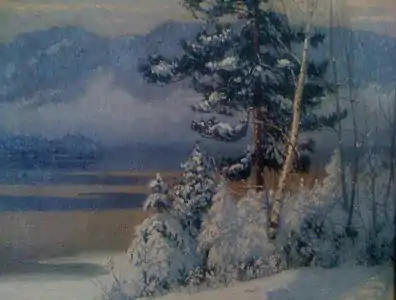Maurice Cullen | |
|---|---|
.jpg.webp) | |
| Born | Maurice Galbraith Cullen 6 June 1866 |
| Died | 28 March 1934 (aged 67) Chambly, Quebec, Canada |
| Education | Montreal, Conseil des Arts et Manufactures (sculpture); Montreal, with sculptor Louis-Philippe Hébert, 1880s; Paris, École des Beaux Arts, with Élie Delaunay, 1889–1892, turned from sculpture to painting; Paris, with Alfred Philippe Roll |
| Known for | Painter, teacher at Art Association of Montreal (1911) |
| Movement | Impressionism |
| Spouse | Barbara Merchant Pilot (married 1910) |
| Awards | Associate, Société Nationale des Beaux-Arts, Paris, 1895; Associate, Royal Canadian Academy, 1899; member, R.C.A., 1907 |
Maurice Cullen RCA (June 6, 1866 – March 28, 1934) is considered to be one of the first Impressionist artists in Canada. He is best known for his paintings of snow and his depictions of ice harvest scenes, featuring horse-drawn sleighs traveling across the frozen waters of Quebec during winter.
Life and work
Cullen was born in St. John's, Newfoundland Colony.[1] In 1870 his family moved to Montreal, Quebec where he began his art training studying sculpture at the Conseil des Arts et Manufactures and with the sculptor Louis-Philippe Hébert at the Monument National.[2][3] In 1888, he travelled to Paris and took courses at the École des Beaux-Arts with Jean-Léon Gérôme and at the Académie Colarossi with Gustave Courtois and L.A. Rixens. He later studied at the Académie Julian and was admitted to the École des Beaux-Arts in 1890 and studied with Élie Delaunay and Alfred Philippe Roll.
Although he received academic training, he was influenced in his painting by the Impressionists, especially Claude Monet and, as early as 1891, critics gave positive reviews to his Impressionist-influenced work. In 1895, the French Government purchased a painting entitled Été from the Société's annual salon (now at the Musée de Pithiviers) and he was elected an associate of the Société Nationale des Beaux-Arts – the first Canadian to be so honoured.
However, in 1895,, he returned to Montreal and made it his home, turning from French subjects to Canadian ones, with an emphasis on snowscapes and using a modified Impressionist technique.[3] Besides the Quebec landscape, he became the chronicler of the city. In 1910, he married Barbara Merchant Pilot, a widow whose son, his stepson, grew up to be the artist Robert Wakeham Pilot. In the same year, he was invited to be a member of the progressive Canadian Art Club (1910).[3] Cullen set an example for other Canadian painters. A. Y. Jackson said of him,
"To us, he was a hero."[3]
Beginning in January 1918, Cullen served with Canadian forces in the First World War. He came to the attention of Lord Beaverbrook, who arranged for him to be commissioned as one of the Canadian official war artists along with Frederick Varley, J.W. Beatty and C. W. Simpson.[4]
Exhibitions
William Robinson Watson (1887–1973) in Montreal, of Watson Art Gallery, represented Cullen and published a book on him in 1931.[5] An exhibition, Legacies of Impressionism in Canada: Three Exhibitions, was held from January 31 to April 19, 2009 at the Vancouver Art Gallery. In 2019, the National Gallery of Canada travelling show, Canada and Impressionism: New Horizons, opened in Munich. It came to the National Gallery in 2022.
Selected works
 The Mill Stream (ca 1905), National Gallery of Canada.
The Mill Stream (ca 1905), National Gallery of Canada. Customs Port, Venice (1897), National Gallery of Canada
Customs Port, Venice (1897), National Gallery of Canada Rising Tide, Le Pouldu, Bretagne (1901), Musée des beaux-arts du Québec
Rising Tide, Le Pouldu, Bretagne (1901), Musée des beaux-arts du Québec Snowfall, Lac Tremblant (1922) Private Collection
Snowfall, Lac Tremblant (1922) Private Collection Winter Evening, Quebec (ca 1905), National Gallery of Canada
Winter Evening, Quebec (ca 1905), National Gallery of Canada Ile d'Orleans landscape, Musée de la civilisation, Quebec
Ile d'Orleans landscape, Musée de la civilisation, Quebec No Man's Land (Douai plain, France) (1920), Canadian War Museum
No Man's Land (Douai plain, France) (1920), Canadian War Museum
Honours
- First Canadian to be elected associate member of Société nationale des Beaux-Arts, Paris, 1895[6]
- Royal Canadian Academy of Arts, elected full member 1907[7]
- Bronze medal, Canadian exhibition at the Louisiana Purchase Exposition, St. Louis, Missouri, 1904[6]
- Awarded Jessie Dow Prize, Art Association of Montreal, 1911, 1913[6]
- Elected first vice-president of Arts Club, Montreal (founded at his studio), 1912[6]
- He was declared a Canadian Person of National Historic Significance in 1944.[8]
See also
Notes
- 1 2 Cybermuse, Maurice Cullen, bio notes Archived 2007-08-16 at archive.today
- ↑ "Maurice Cullen". www.gallery.ca. National Gallery of Canada. Retrieved 31 January 2022.
- 1 2 3 4 Murray, Joan (1973). Impressionism in Canada, 1895-1935. Toronto: Art Gallery of Ontario. p. 18. Retrieved 31 January 2022.
- ↑ Davis, Ann. (1992). The Logic of Ecstasy: Canadian Mystical Painting, 1920–1940, p. 30., p. 30, at Google Books
- ↑ "Watson Art Galleries fonds: Finding Aid". www.gallery.ca. National Gallery of Canada. Retrieved 2020-09-06.
- 1 2 3 4 Cullen, Maurice. "Collection". www.gallery.ca. National Gallery of Canada. Retrieved 2020-09-04.
- ↑ "Members since 1880". Royal Canadian Academy of Arts. Archived from the original on 26 May 2011. Retrieved 11 September 2013.
- ↑ "Maurice Galbraith Cullen National Historic Person". Parks Canada. Retrieved 2010-04-02.
Bibliography
- Antoniou, Sylvia (1982). Maurice Cullen: 1866-1934. Kingston: Agnes Etherington Art Centre. ISBN 0889113696. Retrieved 2020-06-13.
- Bruce, Tobi; Cable, Patrick Shaw (2011). The French Connection: Canadian Painters at the Paris Salons 1880-1900. Hamilton, Ontario: Art Gallery of Hamilton. Retrieved 2021-04-15.
- Davis, Ann (1992). The Logic of Ecstasy: Canadian Mystical Painting, 1920–1940. Toronto: University of Toronto Press. ISBN 9780802059161; ISBN 9780802068613; OCLC 26256269
- Lowrey, Carol, Visions of Light and Air: Canadian Impressionism, 1885–1920, Americas Society, 1996.
- Prakash, A.K. (2015). Impressionism in Canada: A Journey of Rediscovery. Stuttgart: Arnoldsche Art Publishers. pp. 266–295. ISBN 978-3-89790-427-9.
